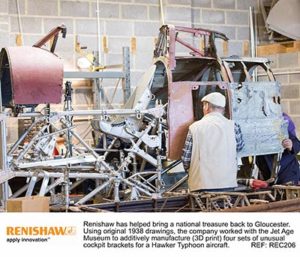Renishaw has helped bring a national treasure back to Gloucester. Using original 1938 drawings, the company worked with the Jet Age Museum to additively manufacture (3D print) four sets of unusual cockpit brackets for a Hawker Typhoon aircraft, built almost exclusively in the UK city during the 1940s.
 Using original drawings from 1938, Renishaw’s engineers modelled each bracket from scratch using a computer-aided design (CAD) system. After prototyping in plastic polycarbonate, the company produced the final parts using a Renishaw AM250 additive manufacturing machine, which like the original brackets were recreated in an aluminium alloy.
Using original drawings from 1938, Renishaw’s engineers modelled each bracket from scratch using a computer-aided design (CAD) system. After prototyping in plastic polycarbonate, the company produced the final parts using a Renishaw AM250 additive manufacturing machine, which like the original brackets were recreated in an aluminium alloy.
Joshua Whitmore, development technician at Renishaw says: “Reconstructing the brackets with traditional manufacturing technologies such as CNC machining was not feasible, so we suggested using additive manufacturing. The design flexibility of additive manufacturing allowed us to create and produce the cockpit brackets quickly and efficiently. It was inspiring to see the latest additive manufacturing technology being used to recreate a part of history.”
The Jet Age Museum rescued the Typhoon from a scrap yard in the early 90s and has been working on the restoration project of returning the aircraft to its original home ever since.
Trevor Davies, Typhoon sponsor coordinator for the Jet Age Museum says: “There are currently no working Hawker Typhoons in existence and complete aircrafts are extremely rare.”
“Renishaw has helped to bring a rare piece of heritage back to the area. We cannot put a price on what the company has done for the Typhoon, the museum and the local community. The aircraft will stand as inspiration to younger generations in the area for years to come. Without Renishaw’s additive manufacturing capabilities, we would not have been able to reproduce the brackets as authentic parts of the restoration.”
For a full case study and videos about the project, see www.renishaw.com/hawkerjet
Renishaw plc
Tel: 01453 524524
Email: uk@renishaw.com
www.renishaw.com